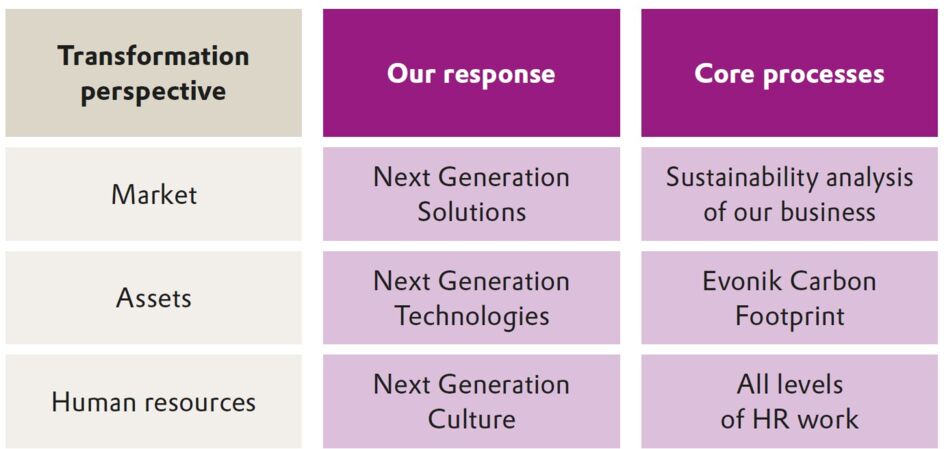Sustainability Strategy
Evonik embarked on the next phase of its strategic business transformation in 2022. As part of Next Generation Evonik, sustainability is becoming an integral element of important core processes such as portfolio and innovation management, production and technology, and human resources work. This strategic integration paves the way for us to meet our promise to be an enabler of sustainability in a wide range of markets and areas of life.
Therefore, we set ourselves ambitious new sustainability targets in the reporting period. These relate, for example, to the transformation of our portfolio and the continuation of our climate strategy for the period 2021 through 2030, in keeping with our commitment to the Science Based Targets initiative (SBTi).
THE TRANSFORMATION REQUIREMENTS AT EVONIK
In view of the transformation requirements made on our business activities, we draw a distinction between market-driven, location-based, and human resources influences. In line with this, our sustainability strategy is focused on three core processes: Next Generation Solutions (market perspective), Next Generation Technologies (asset perspective), and Next Generation Culture (human resources perspective). Between 2021 and 2030, we aim to invest more than €3 billion in the growth of our Next Generation Solutions, in other words, products and solutions whose sustainability profile is above or even significantly above the market reference level. In the same period, we intend to invest €700 million in Next Generation Technologies. These are, in particular, measures at production plants and infrastructure that are geared to our goal of further reducing our CO2 emissions. The aim of Next Generation Culture is to establish sustainability firmly at all levels of the human resources process—from recruiting through training and continuing professional development to incentive systems and ideas management.
Transformation requirements and core processes

RELEVANT OBJECTIVES OF THE SUSTAINABILITY STRATEGY
Through our sustainability strategy, we address the UN Sustainable Development Goals (SDGs) of particular relevance for Evonik. This strategy comprises the following elements:
- Giving sustainability a firm place in our market proposition and purpose
- Integrating sustainability into our strategic management process
- Increasing the proportion of attractive growth businesses in our portfolio with a clear focus on sustainability, p. xx, “Portfolio transformation”
- Foresighted resource management with ambitious environmental targets, including systematically considering the impact of our business along the value chain and on the SDGs
- Selective improvement of our sustainability reporting
SUSTAINABILITY ANALYSIS OF THE Businesses
The sustainability analysis of our business is the key tool for the strategic management and ongoing development of our portfolio. The methodology is based on the chemical industry standard for portfolio analysis. The extensive evaluation of these sustainability signals in all three dimensions of sustainability—economic, ecological, and social—gives us insights for the foresighted management of individual products and entire business areas. The results of the analysis are used in our strategic management process.
CLIMATE TARGETS 2021 – 2030
In 2022, Evonik committed to the Science Based Target initiative (SBTi). SBTi is a partnership of CDP, United Nations Global Compact, World Resources Institute and World Wide Fund for Nature.
In the year under review, SBTi successfully validated the emission reduction targets submitted by Evonik. In doing so, SBTi confirmed that the level of ambition of the Scope 1 and Scope 2 targets is suitable for helping to reduce global warming to well below 2°C. Our overarching Scope 1 and
The Scope 2 target envisages a 25 percent reduction in the corresponding emissions between 2021 and 2030.
In addition, Evonik has committed itself to reducing all other Scope 3 emissions from all upstream categories and the downstream category "Transportation and Distribution" by 11.07 percent over the same period.
